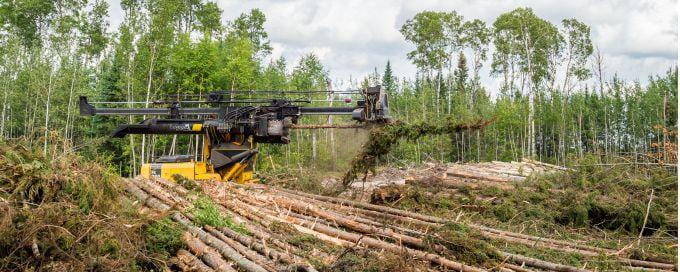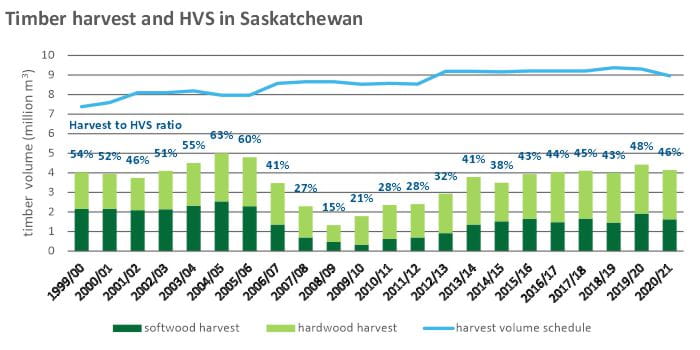
Why we measure this
Healthy forests provide many benefits such as clean air, fresh water, healthy soils, habitat for plants and animals, and materials for building homes and printing books. Forest management is based on the concept that forests change over time; young trees grow and reach maturity. During this time a forest may be cut for wood products, be burned in wildfires, or continue growing until it becomes old and eventually falls over or is killed by insects or disease.
Forest management plans are developed by professional foresters to care for the forest. When trees are cut following these plans, the harvest is sustainable, meaning that the forests and the benefits they provide will always be there. In Saskatchewan's managed forests, more trees are growing back than are being cut. This means that the forest will grow older than planned, and more tree cutting may be needed to help the forests stay healthy.
What is happening

For each timber supply area in the commercial forest and fringe forest (Crown agriculture) zones, a harvest volume schedule (HVS) is calculated. The HVS in Saskatchewan is also known as the annual allowable cut or the sustainable wood supply in other Canadian jurisdictions. The HVS is determined based on the results of a timber supply analysis, which assesses the selected long-term forest resource management strategy using complex computer modelling. To ensure forest sustainability, the amount of timber harvested must not exceed the HVS for a specified term. Timber harvesting on private and federal lands is not regulated in Saskatchewan. For this indicator, timber harvested from private and federal lands have been included and the HVS has been estimated.
HVS compared to actual harvest is a key performance indicator of sustainable forest management. This comparison provides information on the over- or under-utilization of available wood supply and how the forestry industry is performing relative to its allocation of timber. Additionally, it highlights potential investment opportunities in the forestry sector. A higher ratio of actual harvest to HVS can be an indicator that the forest industry is performing well, whereas a low ratio may indicate a downturn.
The low actual harvest to HVS ratios observed between 2006 and 2009 in Saskatchewan's commercial forest zone mirrored a period of global economic recession. Since then, as the forest industry recovers, the ratio of actual harvest to HVS has increased. However, the ratio has not yet returned to pre-recession levels. In 2020-21, of the 8.96 million cubic metre provincial HVS, 4.15 million cubic metres of timber were harvested from Saskatchewan's commercial forest and fringe forest zones. This represents a 46 per cent harvest to HVS ratio. As a result, Saskatchewan's commercial forest and fringe forest zone will age and potentially be more susceptible to natural disturbances, such as wildfires, insects and disease.

What we are doing
Licensees are required to ensure their timber harvest levels do not exceed the HVS and stakeholders want assurance that overharvesting is not occurring in provincial forests. This indicator provides stakeholders with evidence that the harvest at the provincial scale is being conducted in a sustainable manner.
For more information on the forest sector in Saskatchewan, visit saskatchewan.ca/forestry.
